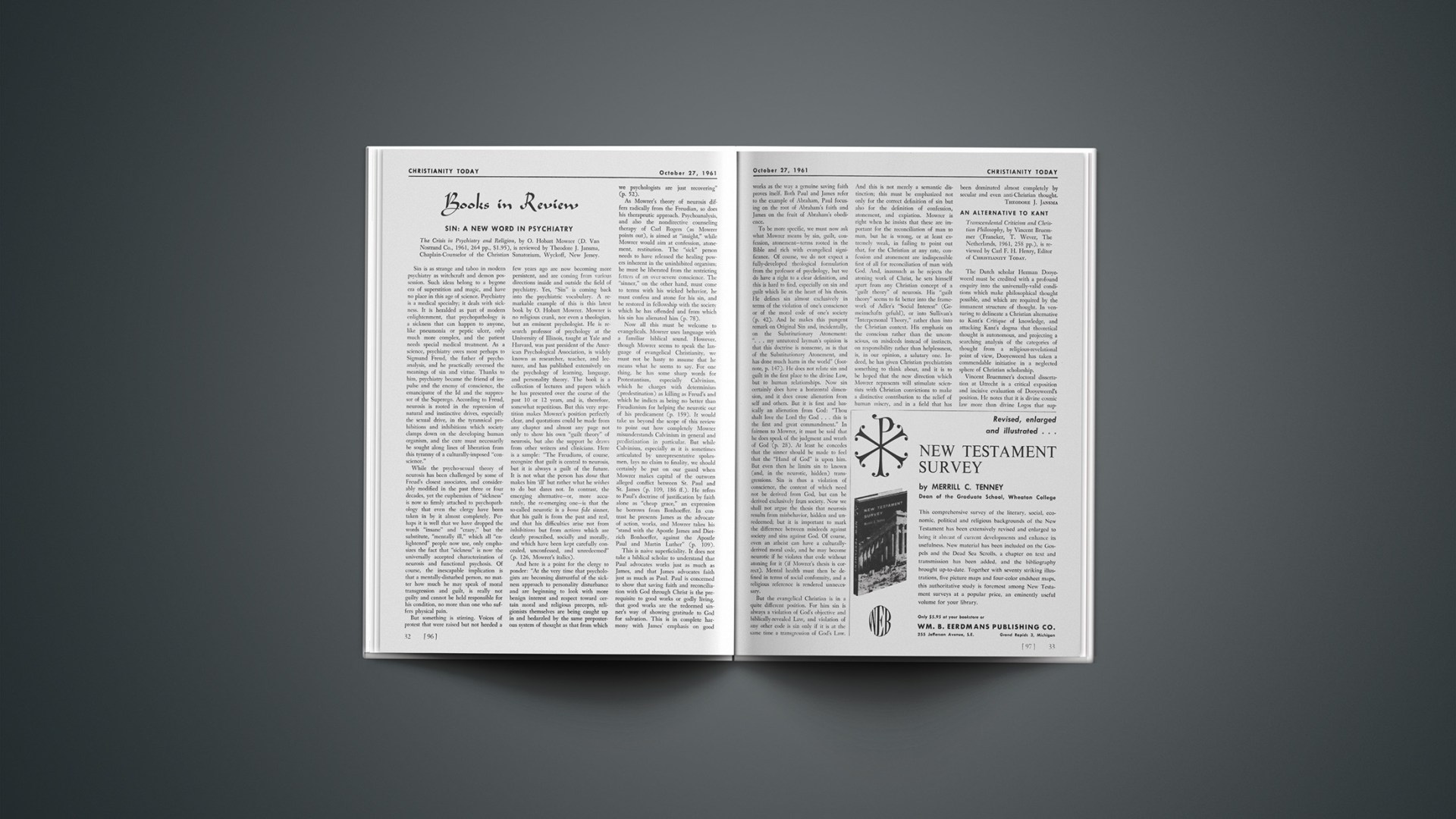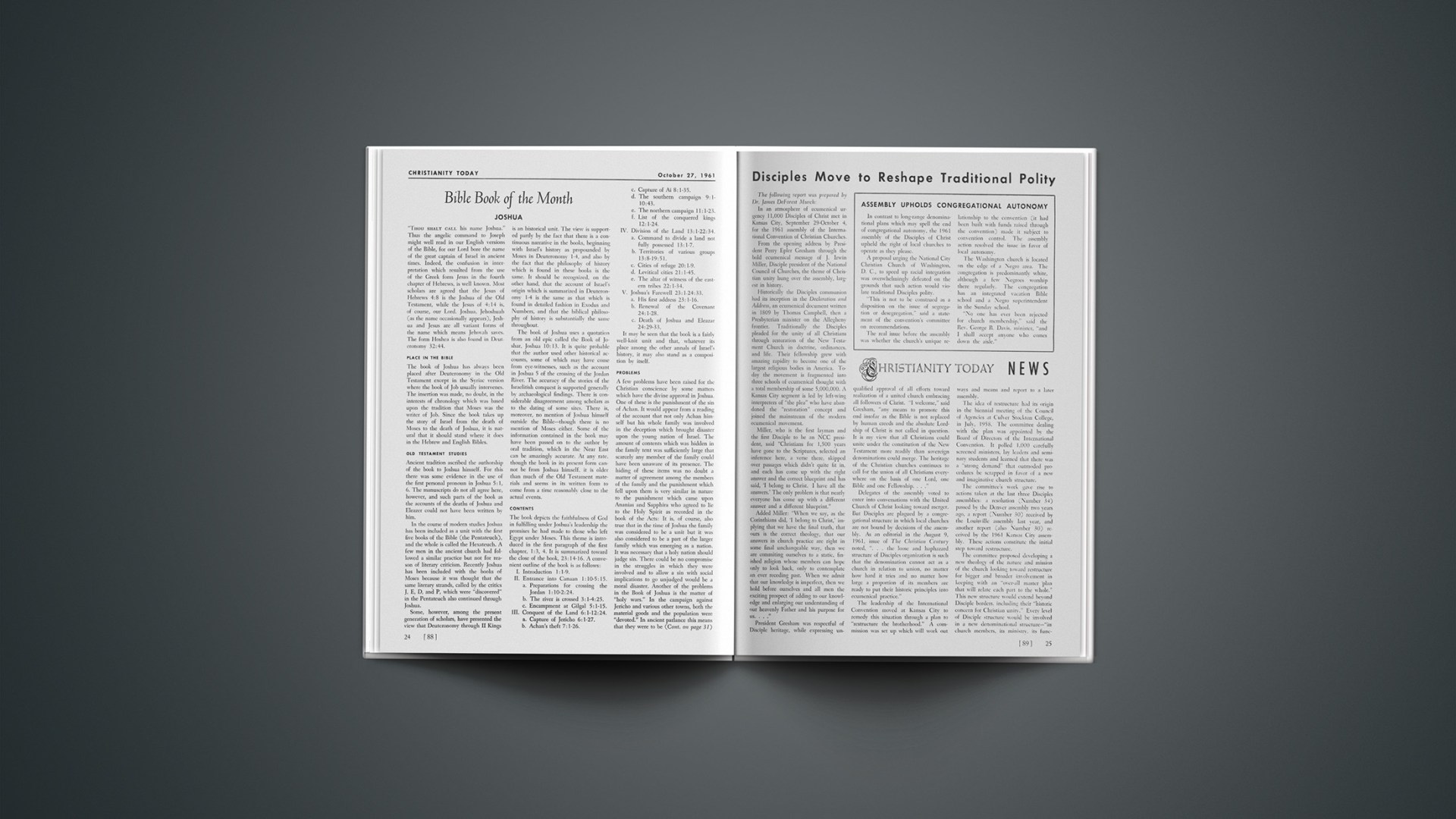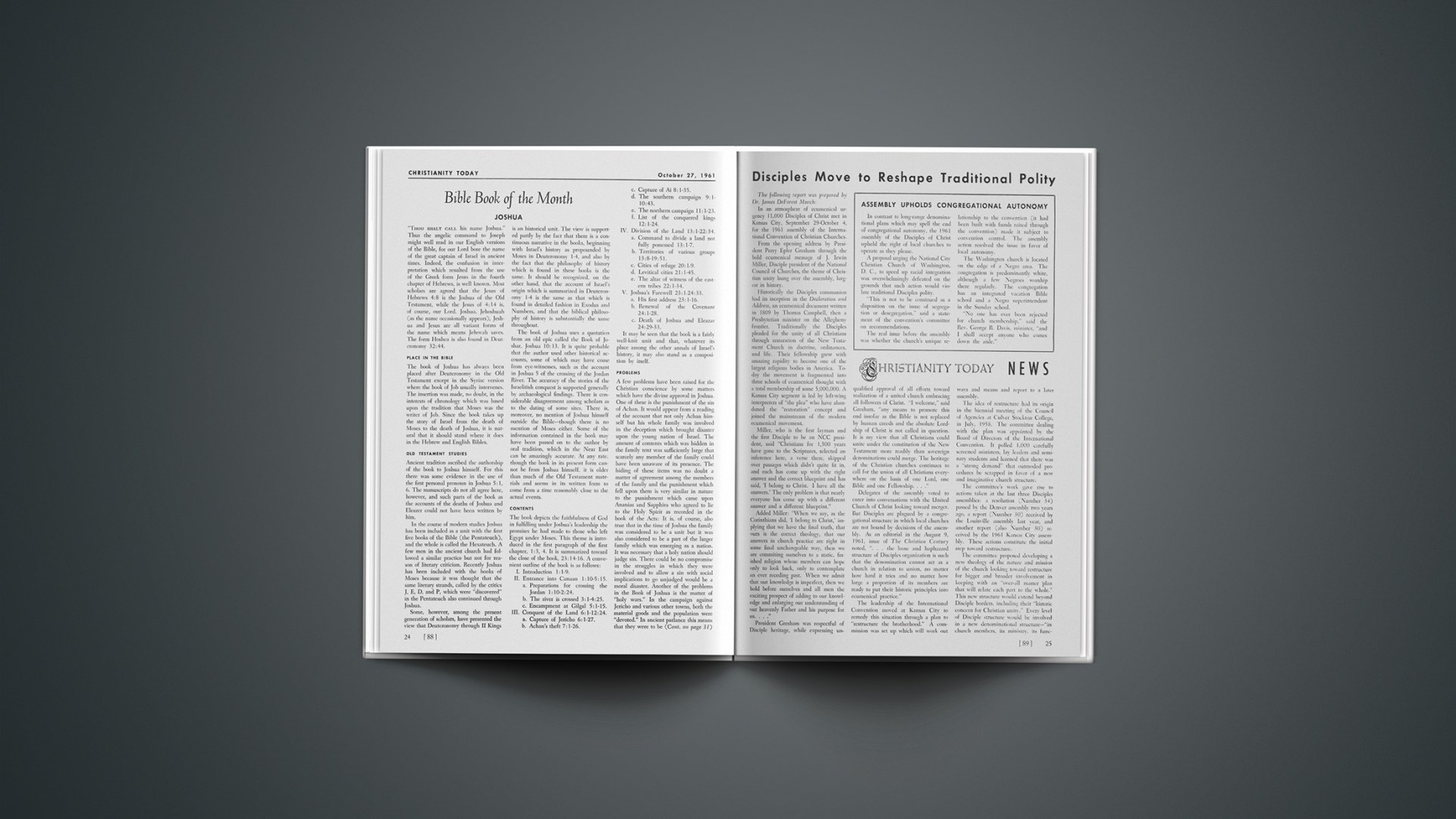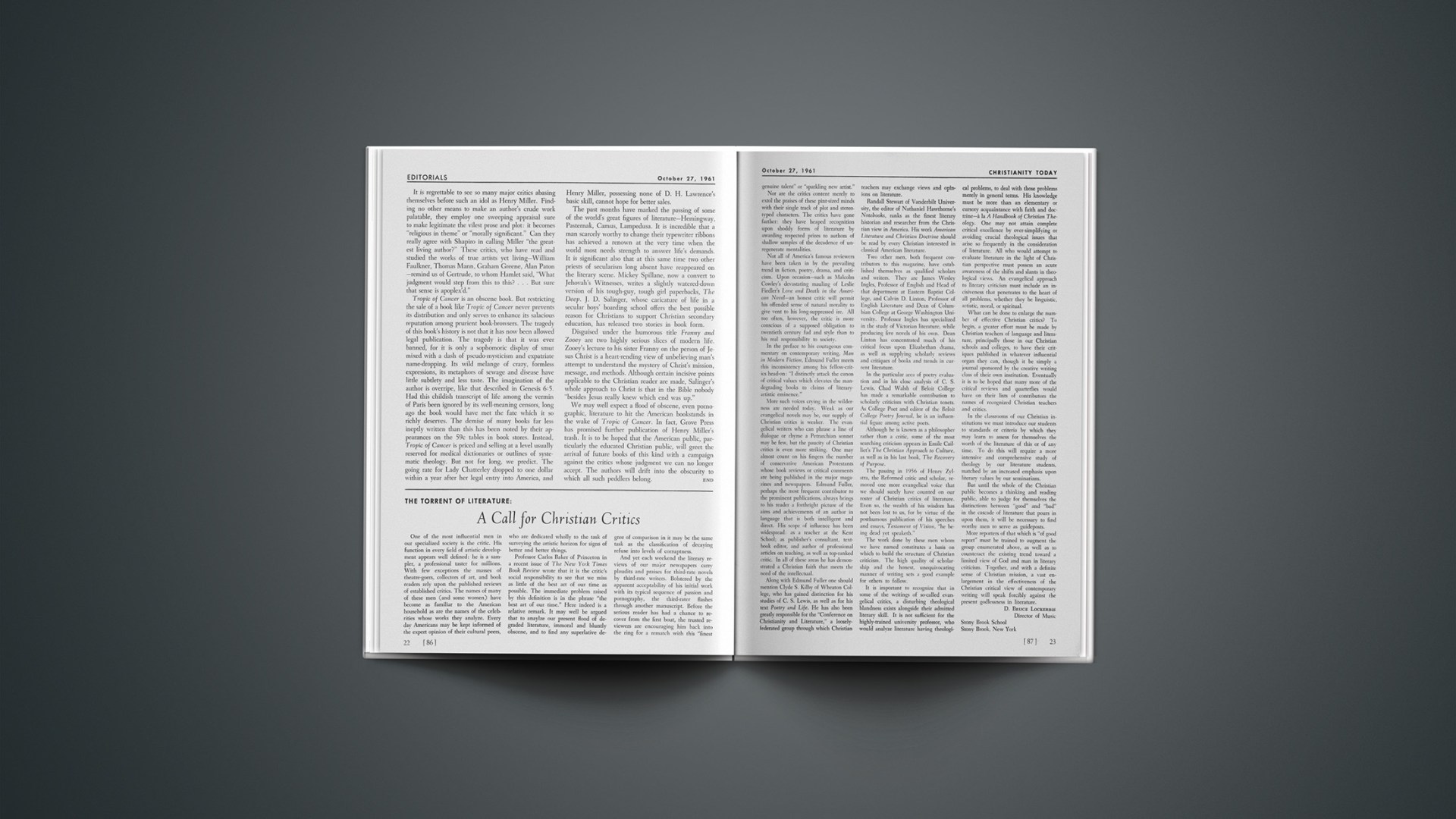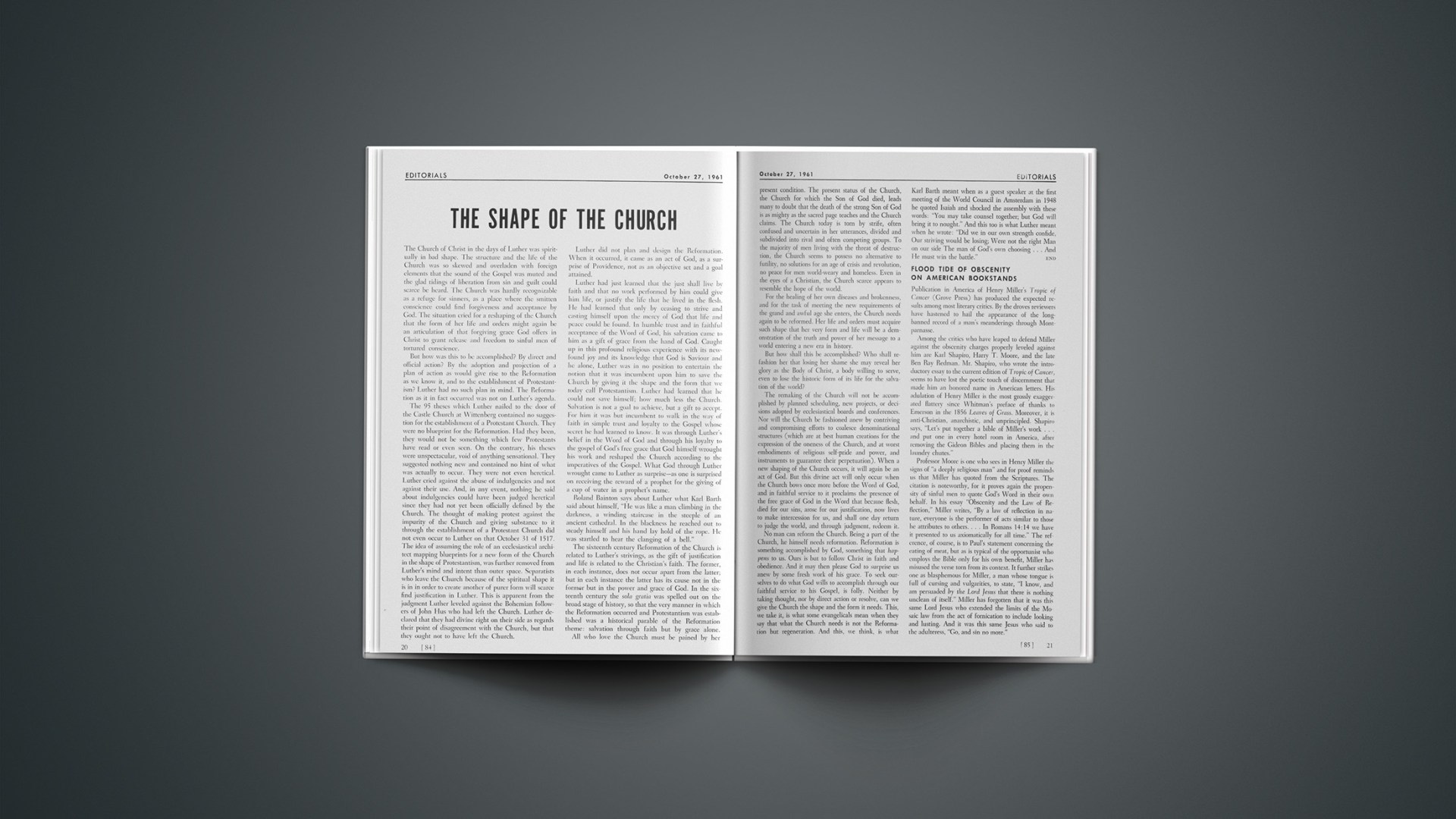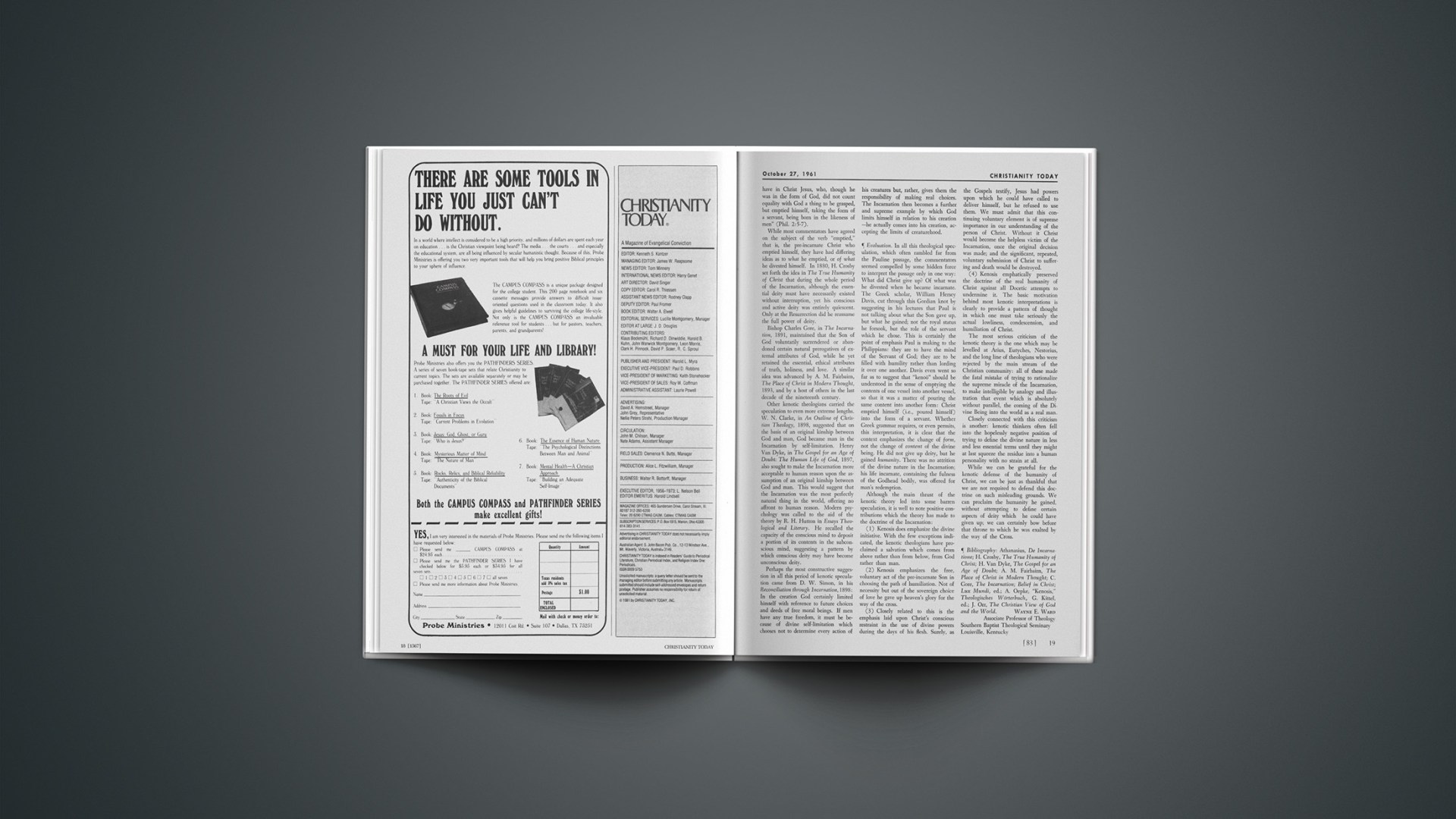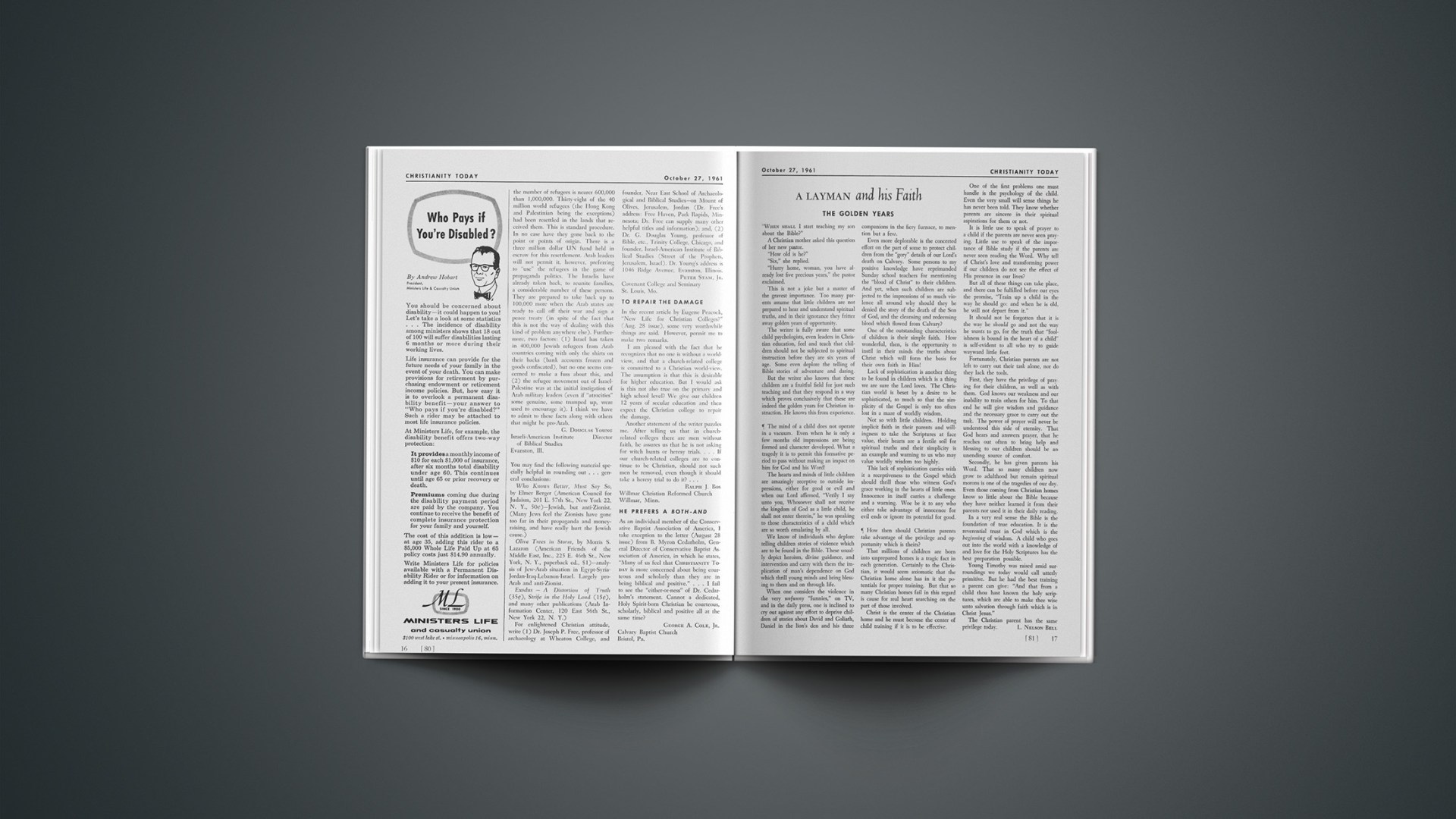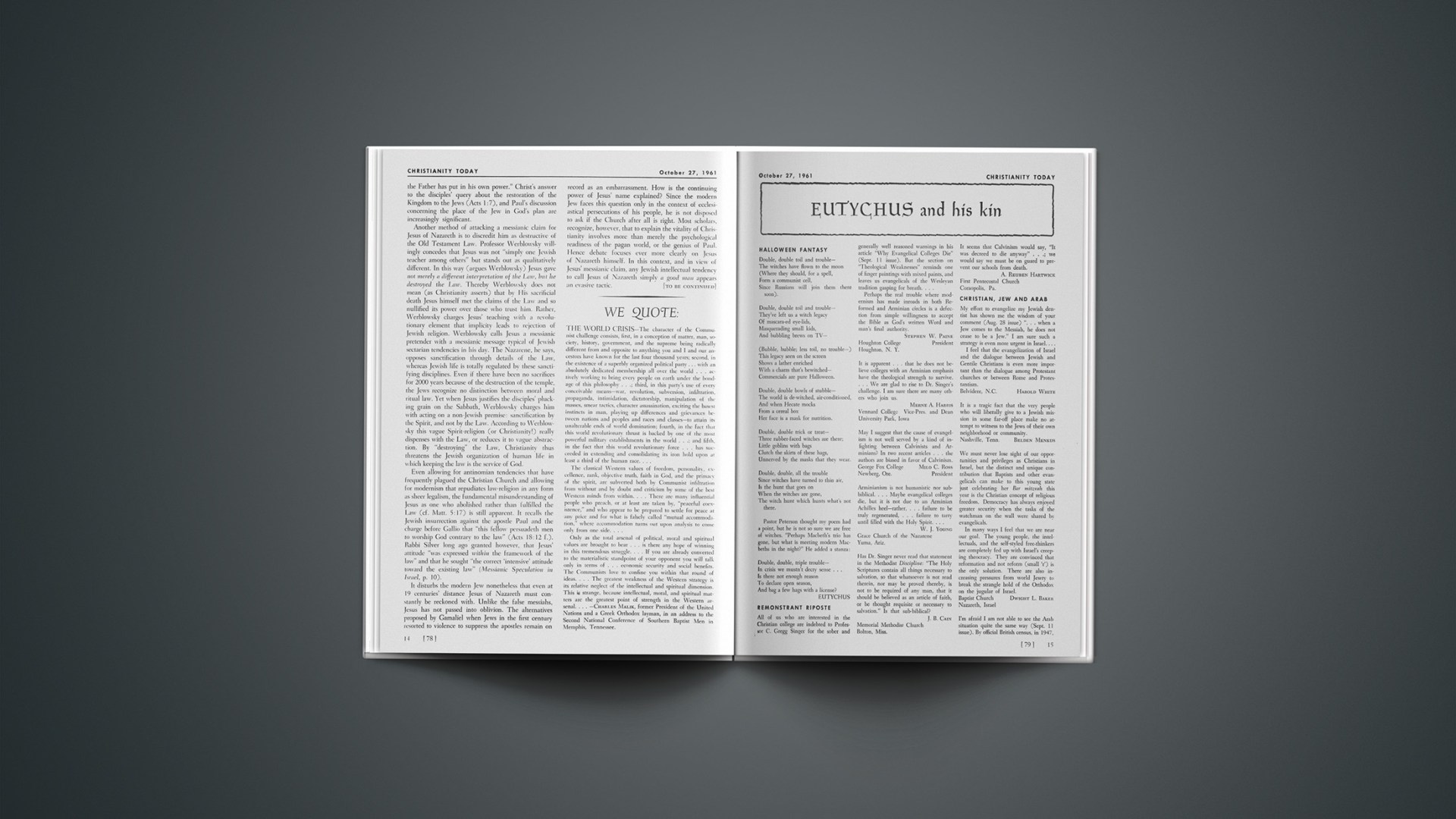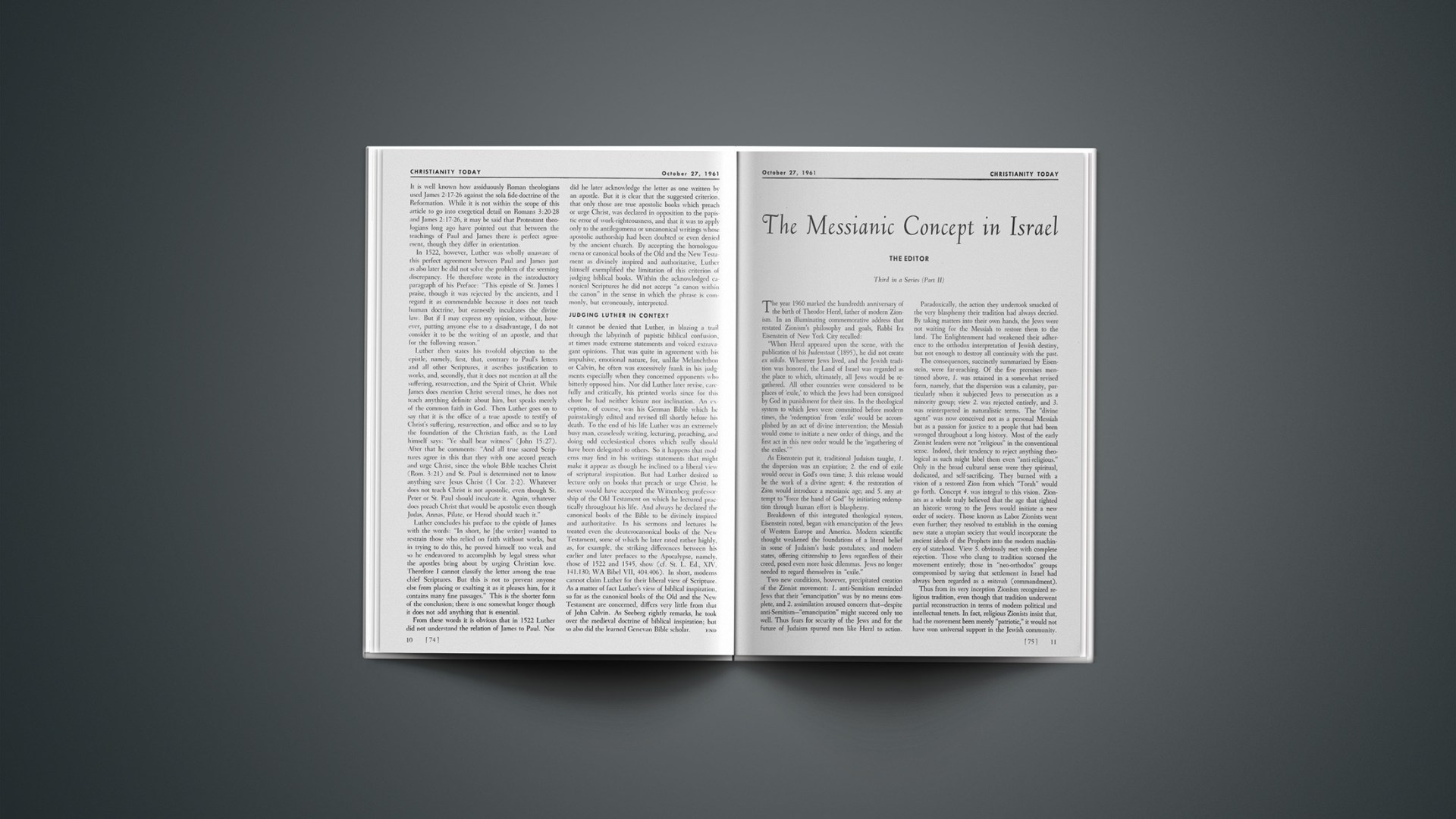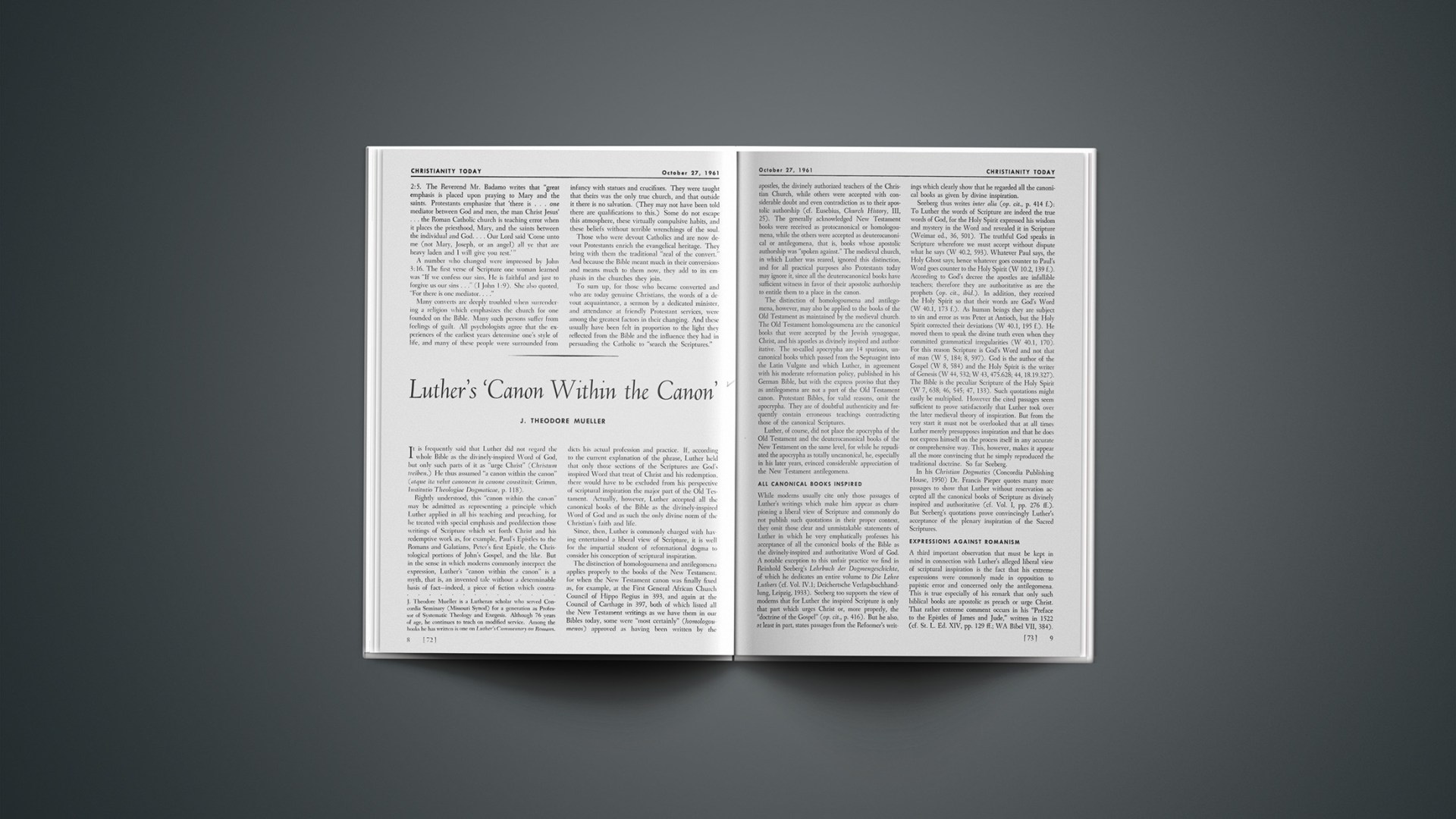Sin: A New Word In Psychiatry
The Crisis in Psychiatry and Religion, by O. Hobart Mowrer (D. Van Nostrand Co., 1961, 264 pp., $1.95), is reviewed by Theodore J. Jansma, Chaplain-Counselor of the Christian Sanatorium, Wyckoff, New Jersey.
Sin is as strange and taboo in modern psychiatry as witchcraft and demon possession. Such ideas belong to a bygone era of superstition and magic, and have no place in this age of science. Psychiatry is a medical specialty; it deals with sickness. It is heralded as part of modern enlightenment, that psychopathology is a sickness that can happen to anyone, like pneumonia or peptic ulcer, only much more complex, and the patient needs special medical treatment. As a science, psychiatry owes most perhaps to Sigmund Freud, the father of psychoanalysis, and he practically reversed the meanings of sin and virtue. Thanks to him, psychiatry became the friend of impulse and the enemy of conscience, the emancipator of the Id and the suppressor of the Superego. According to Freud, neurosis is rooted in the repression of natural and instinctive drives, especially the sexual drive, in the tyrannical prohibitions and inhibitions which society clamps down on the developing human organism, and the cure must necessarily be sought along lines of liberation from this tyranny of a culturally-imposed “conscience.”
While the psycho-sexual theory of neurosis has been challenged by some of Freud’s closest associates, and considerably modified in the past three or four decades, yet the euphemism of “sickness” is now so firmly attached to psychopathology that even the clergy have been taken in by it almost completely. Perhaps it is well that we have dropped the words “insane” and “crazy,” but the substitute, “mentally ill,” which all “enlightened” people now use, only emphasizes the fact that “sickness” is now the universally accepted characterization of neurosis and functional psychosis. Of course, the inescapable implication is that a mentally-disturbed person, no matter how much he may speak of moral transgression and guilt, is really not guilty and cannot be held responsible for his condition, no more than one who suffers physical pain.
But something is stirring. Voices of protest that were raised but not heeded a few years ago are now becoming more persistent, and are coming from various directions inside and outside the field of psychiatry. Yes, “Sin” is coming back into the psychiatric vocabulary. A remarkable example of this is this latest book by O. Hobart Mowrer. Mowrer is no religious crank, nor even a theologian, but an eminent psychologist. He is research professor of psychology at the University of Illinois, taught at Yale and Harvard, was past president of the American Psychological Association, is widely known as researcher, teacher, and lecturer, and has published extensively on the psychology of learning, language, and personality theory. The book is a collection of lectures and papers which he has presented over the course of the past 10 or 12 years, and is, therefore, somewhat repetitious. But this very repetition makes Mowrer’s position perfectly clear, and quotations could be made from any chapter and almost any page not only to show his own “guilt theory” of neurosis, but also the support he draws from other writers and clinicians. Here is a sample: “The Freudians, of course, recognize that guilt is central to neurosis, but it is always a guilt of the future. It is not what the person has done that makes him ‘ill’ but rather what he wishes to do but dares not. In contrast, the emerging alternative—or, more accurately, the re-emerging one—is that the so-called neurotic is a bona fide sinner, that his guilt is from the past and real, and that his difficulties arise not from inhibitions but from actions which are clearly proscribed, socially and morally, and which have been kept carefully concealed, unconfessed, and unredeemed” (p. 126, Mowrer’s italics).
And here is a point for the clergy to ponder: “At the very time that psychologists are becoming distrustful of the sickness approach to personality disturbance and are beginning to look with more benign interest and respect toward certain moral and religious precepts, religionists themselves are being caught up in and bedazzled by the same preposterous system of thought as that from which we psychologists are just recovering” (p. 52).
As Mowrer’s theory of neurosis differs radically from the Freudian, so does his therapeutic approach. Psychoanalysis, and also the nondirective counseling therapy of Carl Rogers (as Mowrer points out), is aimed at “insight,” while Mowrer would aim at confession, atonement, restitution. The “sick” person needs to have released the healing powers inherent in the uninhibited organism; he must be liberated from the restricting fetters of an over-severe conscience. The “sinner,” on the other hand, must come to terms with his wicked behavior, he must confess and atone for his sin, and be restored in fellowship with the society which he has offended and from which his sin has alienated him (p. 78).
Now all this must be welcome to evangelicals. Mowrer uses language with a familiar biblical sound. However, though Mowrer seems to speak the language of evangelical Christianity, we must not be hasty to assume that he means what he seems to say. For one thing, he has some sharp words for Protestantism, especially Calvinism, which he charges with determinism (predestination) as killing as Freud’s and which he indicts as being no better than Freudianism for helping the neurotic out of his predicament (p. 159). It would take us beyond the scope of this review to point out how completely Mowrer misunderstands Calvinism in general and predistination in particular. But while Calvinism, especially as it is sometimes articulated by unrepresentative spokesmen, lays no claim to finality, we should certainly be put on our guard when Mowrer makes capital of the outworn alleged conflict between St. Paul and St. James (p. 109, 186 ff.). He refers to Paul’s doctrine of justification by faith alone as “cheap grace,” an expression he borrows from Bonhoeffer. In contrast he presents James as the advocate of action, works, and Mowrer takes his “stand with the Apostle James and Dietrich Bonhoeffer, against the Apostle Paul and Martin Luther” (p. 109).
This is naive superficiality. It does not take a biblical scholar to understand that Paul advocates works just as much as James, and that James advocates faith just as much as Paul. Paul is concerned to show that saving faith and reconciliation with God through Christ is the prerequisite to good works or godly living, that good works are the redeemed sinner’s way of showing gratitude to God for salvation. This is in complete harmony with James’ emphasis on good works as the way a genuine saving faith proves itself. Both Paul and James refer to the example of Abraham, Paul focusing on the root of Abraham’s faith and James on the fruit of Abraham’s obedience.
To be more specific, we must now ask what Mowrer means by sin, guilt, confession, atonement—terms rooted in the Bible and rich with evangelical significance. Of course, we do not expect a fully-developed theological formulation from the professor of psychology, but we do have a right to a clear definition, and this is hard to find, especially on sin and guilt which lie at the heart of his thesis. He defines sin almost exclusively in terms of the violation of one’s conscience or of the moral code of one’s society (p. 42). And he makes this pungent remark on Original Sin and, incidentally, on the Substitutionary Atonement: “… my untutored layman’s opinion is that this doctrine is nonsense, as is that of the Substitutionary Atonement, and has done much harm in the world” (footnote, p. 147). He does not relate sin and guilt in the first place to the divine Law, but to human relationships. Now sin certainly does have a horizontal dimension, and it does cause alienation from self and others. But it is first and basically an alienation from God: “Thou shalt love the Lord thy God … this is the first and great commandment.” In fairness to Mowrer, it must be said that he does speak of the judgment and wrath of God (p. 28). At least he concedes that the sinner should be made to feel that the “Hand of God” is upon him. But even then he limits sin to known (and, in the neurotic, hidden) transgressions. Sin is thus a violation of conscience, the content of which need not be derived from God, but can be derived exclusively from society. Now we shall not argue the thesis that neurosis results from misbehavior, hidden and unredeemed; but it is important to mark the difference between misdeeds against society and sins against God. Of course, even an atheist can have a culturally-derived moral code, and he may become neurotic if he violates that code without atoning for it (if Mowrer’s thesis is correct). Mental health must then be defined in terms of social conformity, and a religious reference is rendered unnecessary.
But the evangelical Christian is in a quite different position. For him sin is always a violation of God’s objective and biblically-revealed Law, and violation of any other code is sin only if it is at the same time a transgression of God’s Law.
And this is not merely a semantic distinction; this must be emphasized not only for the correct definition of sin but also for the definition of confession, atonement, and expiation. Mowrer is right when he insists that these are important for the reconciliation of man to man, but he is wrong, or at least extremely weak, in failing to point out that, for the Christian at any rate, confession and atonement are indispensible first of all for reconciliation of man with God. And, inasmuch as he rejects the atoning work of Christ, he sets himself apart from any Christian concept of a “guilt theory” of neurosis. His “guilt theory” seems to fit better into the framework of Adler’s “Social Interest” (Gemeinschafts gefuhl), or into Sullivan’s “Interpersonal Theory,” rather than into the Christian context. His emphasis on the conscious rather than the unconscious, on misdeeds instead of instincts, on responsibility rather than helplessness, is, in our opinion, a salutary one. Indeed, he has given Christian psychiatrists something to think about, and it is to be hoped that the new direction which Mowrer represents will stimulate scientists with Christian convictions to make a distinctive contribution to the relief of human misery, and in a field that has been dominated almost completely by secular and even anti-Christian thought.
THEODORE J. JANSMA
An Alternative To Kant
Transcendental Criticism and Christian Philosophy, by Vincent Bruemmer (Franeker, T. Wever, The Netherlands, 1961, 258 pp.), is reviewed by Carl F. H. Henry, Editor of CHRISTIANITY TODAY.
The Dutch scholar Herman Dooyeweerd must be credited with a profound enquiry into the universally-valid conditions which make philosophical thought possible, and which are required by the immanent structure of thought. In venturing to delineate a Christian alternative to Kant’s Critique of knowledge, and attacking Kant’s dogma that theoretical thought is autonomous, and projecting a searching analysis of the categories of thought from a religious-revelational point of view, Dooyeweerd has taken a commendable initiative in a neglected sphere of Christian scholarship.
Vincent Bruemmer’s doctoral dissertation at Utrecht is a critical exposition and incisive evaluation of Dooyeweerd’s position. He notes that it is divine cosmic law more than divine Logos that supplies the content of Dooyeweerd’s philosophic ground-idea. Dooyeweerd asserts that the speculative Greek view attributed prime significance to the intellect and hence, he says, tried to construe a rational harmony in the cosmos whereas the Christian view finds the unity of the cosmogonic order rather in a transcendent divine harmony in the will of God. The sovereignty of the divine creative will is affirmed in independence of the rational nature of God (cf. Bruemmer, pp. 143 ff.). The law is affirmed as absolute boundary between divine and human reason as well as between divine and human will (ibid., p. 149).
Dooyeweerd stresses that despite the knower’s ability theoretically to distinguish the various modal functions of the concrete act of knowledge, in the concrete act of knowledge the corresponding modal aspects of the cosmic meaning-structure are involved in their mutual intercoherence. Whereas theoretical thought because of its problematic character breaks up experience into various abstracted modal aspects, the naive “pretheoretical” attitude leaves intact the cosmic meaning-coherence and directs itself to concrete things and events. Bruemmer shows that this antithetical representation is unsatisfactory, and provides an inadequate basis for dealing with the epistemological problem of synthesis: “like Kant … Dooyeweerd initiates his philosophy by isolating the logical and nonlogical ‘modalities’: Kant does this through abstraction, Dooyeweerd through the principle of sphere-sovereignty. From the start the intrinsic coherence between the logical and the nonlogical appears to be problematic in the philosophies of both Kant and Dooyeweerd. It is hardly surprising to find both of them faced with the epistemological problem of synthesis between the various law-spheres, a problem which is central in the transcendental critique of both” (ibid., p. 160). Dooyeweerd in fact may be viewed as less affirmatively rational than Kant. While both affirm that the cosmos is an order of meaning, Dooyeweerd does not limit meaning, as Kant does, to logical meaning (ibid., p. 164). In fact, whereas Kant’s theory of antinomy presupposes the law of noncontradiction, Dooyeweerd rejects the universal cosmological relevance of this logical principle. Alternative to Kant’s denial of the ontic and noetic articulation of the cosmos by the divine Logos, and to Kant’s view that the logical consciousness of man produces the meaning-structure of the phenomenal world, Dooyeweerd limits the logical modality to one law-sphere in isolation from the others and denies that the ultimate cosmological principle is logical. Instead of insisting that the cosmic meaning structure has a logical character grounded in the divine creative Logos, Dooyeweerd considers cosmic meaning as a structure of divine laws. Hence Dooyeweerd opposes his cosmonomic Idea not only to Kant but also to Abraham Kuyper and other theologians who hold that the cosmos has a logical structure (ibid., pp. 175 ff.).
A prime criticism of Dooyeweerd is not his insistence that the relation between God and creation is that of purposive will, but the failure to stress that the divine sovereign will is rational, and that the cosmos owes its origin to the divine creative Logos. For both the Genesis creation account and John’s prologue refer the concrete realization of God’s purposive will to the creative Word. The assertion that the whole creation is grounded in the divine will requires, rather than disallows, the creation and preservation of the universe and its cosmic meaning to the Logos.
Bruemmer develops the self-defeating implications of Dooyeweerd’s position in a careful manner. His dissertation is a worthy contribution. The publication has some unfortunate typographical errors: “though” for “thought” (p. 13); “wich” for “which” (p. 103); “reserve” for “reverse” (p. 190); “oragin” for “origin” (p. 177).
CARL F. H. HENRY
T.V. And The Gospel
Religions Television, by Everett C. Parker (Harper, 1961, $4), is reviewed by Lee Shane, Minister, National Baptist Church, Washington, D. C.
Most of us read book reviews to discover if the book in question is one that would interest or be of help to us. Religions Television will be of enormous interest and value to anyone engaged in any phase of this media—ministers and laymen responsible for religious television programs, members of ministerial councils or councils of churches whose responsibility is guiding and planning religious programs for the community, people in the industry, station managers, program directors.
For the most part the book deals with down-to-earth techniques of program development from the germinal ideas, through the format, writing of script, casting, proping, directing, budgeting, promotion, and evaluating. This is a completely understandable and practical “how to” book and one quite indispensable to anyone seriously concerned with communication of the Gospel by television.
The first two chapters deal with judgments out of which religious television stems and propound new strategy for using the media. Aims and goals and obligation are stressed. The next eight chapters deal with broadcasting techniques and program ideas which all faiths using this media will find most helpful. The final chapter again points up judgments on the industry and deals with the ethics of mass communication.
LEE SHANE
Grace, An Afterthought
On the Eternal in Man, by Max Scheler, translated by Bernard Noble (Harper, 1960, 480 pp., $10), is reviewed by Cornelius Van Til, Professor of Apologetics, Westminster Theological Seminary.
Max Scheler was, says I. M. Bochenski, “beyond doubt the most brilliant thinker of his day” (p. 471). Bochenski adds: “After St. Augustine, Scheler received the most lasting impressions from life-philosophy, Nietzsche, Dilthey, and Bergson, which accounts for his title ‘the Catholic Nietzsche’ (Troeltsch)” (ibid.).
The most important material of the present volume is that which deals with religion. Scheler is particularly interested in the relation of natural to positive religion.
By way of illustration we summarize what he says on “Repentance and Rebirth.”
Scheler finds that “the deepest understanding of the meaning and significance of Repentance is to be encountered in Christianity and, within Christianity, in the Catholic Church” (p. 63).
Repentance, says Scheler, “effects moral rejuvenation. Young forces, as yet guiltless, are dormant in every soul. But they are hampered, indeed smothered, by the tangled growths of oppressive guilt which in the course of time have gathered and thickened within the soul. Tear away the undergrowth, and those forces will rise up of their own accord” (p. 42). “Repentance, at least in its perfect form, genuinely annihilates the psychic quality called ‘guilt’ ” (p. 55). It thus enables men “to embark on new and guiltless courses. Repentance is the mighty power of self-regeneration of the moral world, whose decay it is constantly working to avert” (ibid.). There is “no Repentance which does not from its inception enclose the blueprint of a new heart. Repentance annihilates only to create. It is already building secretly where it still seems to destroy. So it is that Repentance forms the driving power of that miraculous process which the gospels call the ‘rebirth’ of a new man out of the ‘old Adam,’ the acquiring of a ‘new heart’ ” (pp. 56–57).
One wonders why Scheler needs anything further. What need is there, on his view, for the objective Atonement through Christ and for the application of that Atonement to sinners by the regenerating work of the Holy Spirit? Even so, Scheler adds grace to nature. He adds God to his purely naturalist view of sin and redemption. Having completed the act of rebirth in its own strength, Scheler’s “soul” “looks up to God” and “learns to understand the renewal and peace of Repentance as the mysterious process known as ‘the forgiveness of sin’ and as an infusion of new strength from the Centre of things. Grace is the name of this strength” (p. 60).
Scheler is well aware of the fact that “the foregoing is still not specifically a Christian thought, and is far from resting on any positive revelation” (p. 61). At this point it is too late for him to add that “it is only through Christian teaching that we are able to understand why Repentance should possess the central function of Rebirth in the life of man” (ibid.).
Scheler exhibits in a particularly striking way the antinomy that confronts any form of the Roman Catholic method of dealing with the central truths of Scripture. The beginning is made on the assumption that man is self-sufficient. After that a futile effort is added to make room for the “primacy of grace.” Thus to deny the basic primacy of grace in order to reach the natural man is virtually to hold that the natural man needs no grace.
CORNELIUS VAN TIL
America’S Ailing Church
A Letter to American Christians, by M. J. Chen (Exposition, 1961, 55 pp., $2.50), is reviewed by E. P. Schulze, Minister, the Lutheran Church of Our Redeemer. Peekskill, New York.
America is not Christian. Her Christendom is mundane. Her Church is not a Christian fellowship. Its terminology is in a semantic quagmire. Its preaching is neglectful of doctrine, is largely “positive” and humanistic; its teaching, frequently based on critical opinion, is pragmatic, and concerned only for the here and now. The social gospel elbows out the gospel of Christ. The fallacy of man’s brotherhood is rife. Faith and works are confused. People populate churches because they are born into “Christian” families or find temporal advantages in joining a church. Churches have degenerated into clubs. Missionary contributions, though comparatively liberal, are often regarded as fashionable.
Unfortunately this is all too frequently true.
Chen’s remedies are, in general, fairly obvious. Inter alia, he pleads for “the resumption of Christian fellowship” which means not syncretism but a concern for the invisible Church that strikes across denominational lines.
This letter, written by a former Buddhist who is now an American pastor, indicts “Protestantism” particularly, but “every Christian” should help correct the abuses.
E. P. SCHULZE
Protestant Social Ethics
The Protestant Search for Political Realism 1919–1941, by Donald B. Meyer (University of California Press, 1960, 482 pp., $6.75), is reviewed by Theodore Minnema, Pastor, South Olive Christian Reformed Church, Holland, Michigan.
A very competent historian has written this book. His competence is manifest in his concise and orderly arrangement of facts, those of main concern being restricted to a period in American Protestantism between 1919 and 1941. The author’s historical orientation is initially evident in the title word “search.” The searching, developing, and forming process of a political philosophy remains the prevailing theme throughout the book.
Between World Wars I and II, American Protestantism was in ferment. Usually this ferment is restricted to theology, and thus Protestantism between the World Wars is reduced too exclusively to a debate and controversy between theological orthodoxy and theological liberalism. Such a reduction obscures and may even distort subordinate but significant tensions in Protestantism. One of these tensions is that between religion and culture which in America became gospel and society. This gospel-society tension in Protestantism the book raises to its warranted place of importance and concern.
Beginning with the social gospel as originated and defined by Rauschenbusch, the author traces out the interplay, conflicts, and realignments between Protestant religion and socio-political thought. Protestant social concern was fostered on the assumptions of liberal theology. The basic liberal assumption of divine immanence was the point of departure. The absolute in some form was emerging in history.
In the Gospel Jesus revealed the will of God or the absolute for man and society. The problem to be solved was the conjunction of God’s will as revealed in the Gospel with some amenable immanent force or power in society. If an immanent power in society could be conjoined with the will of God then the Christian ideal could be realized. By assumption, such an immanent power should be available.
Protestant social concern spent itself in the “search” for a power that would realize the will of God. Capital, labor, and the church as centers of power eventually proved to be impotent in the fulfilling of the will of God in society and politics.
The frustration and disillusionment of unfulfilled ideals caused the social gospel movement to break up into diverging and conflicting currents, the extremes of which were pacifism and communism. Both continued to assume the availability of the absolute, pacifism in the form of means and communism in the form of end or goal.
Out of the social gospel turmoil evolved a third movement under the leadership of Reinhold Niebuhr. This movement arrived at the position of political realism. It claims to be realistic because power is no longer surrounded with the illusions of perfection and identified with the absolute. All power, it maintains, is subject to corruption, and the recognition of this reality must be basic to all political theory. Therefore, all forms of social and political power must seek perfection and fulfillment on some level of existence beyond themselves.
This book offers no final answers to the age-old problem of how to relate Christianity to culture, but it very adequately records and unfolds attempts to arrive at such answers.
THEODORE MINNEMA
God’S Acts In Genesis
The Message of Genesis, by Ralph H. Elliott (Broadman, 1961, 209 pp., $4.50), is reviewed by Robert B. Laurin, Associate Professor of Old Testament, California Baptist Theological Seminary.
Christopher Morley once wrote, “Take your mind out and dance on it; it is getting all caked up!” Here is a book that will help a person to dance the right steps. One of the great difficulties in using the book of Genesis is discovering the intended message. Years of discussion about the problems of harmonizing science and Scripture often blind the reader to what the book is actually all about. The Message of Genesis should prove a steady and trustworthy guide to the primary theological teaching of the book.
Never denying the essential historicity of Genesis, Professor Elliott deftly and irenically shows how the “scientific” and “historical” statements are only vehicles to convey the more important theological message. The inspired authors often used myth or parable or paraphrased history as a teaching method. So the real infallibility of Genesis lies in its disclosure of God’s mighty acts in the creation and salvation of men.
The book, clearly sympathetic with contemporary scholarship, does not allow, in length, for adequate technical and theological treatment at many points. So if it is used along with a few detailed commentaries it should clarify the much-needed message of Genesis for the teacher and preacher.
ROBERT B. LAURIN
Nightmare In Retrospect
The Destruction of the European jews, by Raul Hilberg (Quadrangle Books, Inc., 1961, 788 pp., $14.95), is reviewed by Jacob Gartenhaus, Founder and President of International Board of Jewish Missions, Inc.
Many books have been written on the destruction of the European Jews, but none of them has given such a clear, comprehensive, and comprehensible picture of what actually happened as does this volume by Professor Raul Hilberg.
In the period between the years 1933–45, the German Nazis destroyed 6,000,000 Jews in Europe. So ghastly and gruesome was this wholesale murder that people away from the scene of events could not conceive of such atrocities. When reports became too evident, too insistent, too frequent, they were viewed as an inexplicable mystery by some, and as a nightmare by others.
This volume by Professor Hilberg, which is a product of 10 years of intensive study of the most authentic documents, removes the dark veil of this mystery and gives shape and dimension to the nightmare. The ghost takes on the body of a living creature.
The book is an eye opener and should be read by every thinking person. In it he will re-discover humanity with its frailties, its pitfalls, and rediscovering them he may invoke God’s grace to prevent man from ever being guilty of such crimes again.
Having recommended this monumental, impressive, and instructive work by Professor Hilberg, I feel that a word of caution is necessary to the reader. The author makes the same mistake which other Jewish writers have made over the years and which has been adopted by some Christian writers, that is, of blaming Christianity for most of the suffering of the Jewish people in the dispersion. This is a scurrilous libel which may please only those who fortify the wall of partition between Jews and Christians.
From the very first pages of the book, the reader gets the impression that the Nazis based their atrocities on the teachings of the Church. It is regretfully true that many who cried, “Lord, Lord,” acted in defiance of the Lord’s will. True, many of these “Churchians” were directly and indirectly responsible for much of the Jewish persecution; but this only points up that some people, despite Christ’s command to “love thy neighbor,” often give vent to stored-up atavistic, primeval passions.
The following two facts refute the libel that Christianity has been the main cause of Jewish suffering.
1. Long before the birth of Christianity there were those who sought the destruction of the Jews as, for example, Pharaoh and Hainan. If you read the book Contra Apionem (Against Apion) written by Joseph Flavius who lived in the time of Christ, you will see that already at that time there were several anti-Semitic books on the market. This Jew-baiter, Apion, a Greek Sophist from Egypt who lived in Rome, and who quoted other anti-Semitic writers famous in his time, assails the Jews and accuses them of almost the same sins and crimes as do modem anti-Semites. His slanders against the Jews (in his book Aegyptica) found their way to Tacitus and many other writers in Rome, and it is remarkable how the same defamations, with slight changes according to time and place, have been repeated to this day. The Nazis could have copied from those heathen sources rather than from church leaders whom they disliked no less than they did the Jews.
2. If Christianity were so inimical, so harmful to the Jewish people (as some of the hate-mongers would have us believe), why is it that the Jews have always preferred to live in Christian countries? Even now, only a few Jews live in non-Christian lands and they would escape from there if they could. Another indisputable fact refutes that lie: only Christian countries have helped in the restoration of the Jewish State of Israel, and if it were not for Christian support this State could not withstand the non-Christian world which would eagerly destroy it.
JACOB GARTENHAUS
Echo Of Liberalism
A Historical Approach to the New Testament, by Frederic R. Crownfield (Harper, 1960, 420 pp., $5.50), is reviewed by Glenn W. Barker, Professor of New Testament, Gordon Divinity School.
This book, comprising the material covered in a course introducing the New Testament to the students at Guilford College, commands admiration both for its scope (canon, text, sources, backgrounds, critical problems, life of Jesus, early Christianity, Paul, and later Christianity) and its thoroughness. The material is attractively arranged and intelligently applied. The critical studies reflect use of the primary sources and in most instances include contemporary interpretation of the sources. An exception to this may be the substantial dependence upon Moore and Montefiore as the best interpreters of first-century Judaism.
One criticism that might be pertinent in the critical sections is the overuse of what may be designated “reversal” conclusions. Since it cannot be absolutely established by historical evidence that the Gospels were written by apostles, it does not necessarily follow that the opposite is established, namely that “the Gospels were written by people who were not eyewitnesses, a generation or two after the events they tell about, far from the scenes they depict, in an alien language and under the influences of a strange culture” (p. 73). Moreover, even if this conjecture should be accepted as a reasonable possibility, the conclusion is misleading, for it fails to raise the more significant question of the character of the sources from which the writers ultimately drew their information.
The treatment of the life of Jesus is somewhat unusual in that it reflects in a very able fashion the type of liberalism most popular 10 to 20 years ago. Jesus is best understood as a prophet whose loyalty to his own insight cost him his life (p. 189). The church owes its origin not to Jesus but his followers (p. 143). The ultimate value of the Christian faith is to be found simply in the message of Jesus which “challenges us to give our allegiance and trust to a God who gives good gifts to his children and who, despite the absoluteness of his demands, freely forgives the repentant sinner and even seeks him out while he is still in his sin” (p. 189).
The Suggestions for Further Reading are extensive (15 pp.) although somewhat one-sided. The paucity of modem interpretations of Christianity, the omission of the splendid contributions of Roman Catholic scholarship to critical problems, and the neglect of the more conservative studies must be noted.
Beyond the immediate purpose of the author, the book is significant in revealing both the strength and the weakness of the so-called “historical approach” to the New Testament.
GLENN W. BARKER
A Christian Novel
The Missionaries, by G. W. Target (Duckworth, 1961, 218 pp., 16s.), is reviewed by J. C. Pollock, British author and Contributing Editor of CHRISTIANITY TODAY.
There is such a shortage of good novelists who are Christians (as distinct from scribblers of “Christian novels”) that the emergence of the young British writer G. W. Target is to be warmly welcomed, not so much for the considerable performance of this book as its splendid promise.
The Missionaries explores, in the colloquial of the South London lower-middle income group, two barely related themes. A missionary doctor is released from a London jail after serving sentence for being mixed up with Central African terrorists who are supposed to have murdered his famous Schweitzer-like colleague. The ex-convict is befriended by the narrator, a young office clerk on the fringe of the Denomination (a rather improbable denomination), and his wife. In their jolly home, where a fourth child is expected, the clerk extracts the true story behind the doctor’s unjust conviction.
This book is scarcely what the blurb claims: “a grim and tremendous novel of modem Africa,” for Africa is dealt with at long range, intermittently. But it is exceedingly worth reading for the exploration of the other theme—the mind and home of the narrator. The gradual unfolding of what the young clerk and his wife are like is well done indeed and gives Target the right to be called a novelist, not a mere story teller.
The South Londoner is genuine all through. He is a man of compassion and insight, whimsical, a delightful friend. He can detect hypocrisy without being cruel or pompous. His Christian faith is as realistic as himself, and carries the same conviction as the daily goings-on in his household.
If Target can find a subject more of an entity to which he can bring his vivid imagination and grasp of character, he will become the Lloyd Douglas of the younger generation—with a far more biblically-based and satisfying faith.
J. C. POLLOCK
Brilliance In Disarray
Religion, Culture and Mental Health, a symposium by the Academy of Religion and Mental Health (New York University Press, 1961, 157 pp., $3.50), is reviewed by Lars I. Granberg, Professor of Psychology, Hope College.
This book contains the proceedings of the third Arden House symposium which had as its topic the relationship between religion, culture, and mental health. Participants were drawn from the clergy, theological professors, medicine, psychiatry, psychology, sociology, anthropology, and education. Some are Protestants, some Roman Catholics, some Jews, some religiously uncommitted.
The topic is approached from the sociological, the anthropological, and religious standpoints. Each approach is initiated by a statement from the discussion leader, which is commented upon by designated discussants. This is followed by general discussion. The caliber of the participants may be seen in that Talcott Parsons led the discussion from the sociological viewpoint, Margaret Mead the anthropological perspective, and those participating in the discussion included Gordon Allport, Otto Klineberg, Goodwin Watson, Noel Mailloux and many other persons who are recognized leaders in their fields.
Among the many topics given thoughtful treatment one finds discussion of the move away from positivism in this generation of social scientists, the relationship of society and religion, role relationships of ministers and psychotherapists, the importance of faith and hope in mental health, and even some interesting thoughts on visions, miraculous cures, and magic.
Those who insist upon tightly organized, systematic presentations leading to definite conclusions will most likely find this an irritating book. But it is a rich source of information and insight at many levels which will be a delight to those who can tolerate the disorderly creativeness of brilliant conversation, with its inevitable unevenness, disconcertingly sudden shifts in topic and openendedness.
LARS I. GRANBERG
Patmos Revisited
A Revelation of Jesus Christ, by J. B. Smith (Herald Press, 1961, 369 pp., $5.75) and The Postman of Patmos, by G. A. Hadjiantoniou (Zondervan, 1961, 149 pp., $2.50), are reviewed by Charles C. Ryrie, President, Philadelphia College of the Bible.
A few months ago this reviewer expressed in another periodical the opinion that we are seeing today a revival of interest in prophecy. Here is further proof! Though a Mennonite, J. B. Smith, also known for his Greek-English Conordance, has produced in A Revelation of Jesus Christ a commentary in the finest of the Plymouth Brethren tradition. It is premillennial and pretribulational, but less symbolic than some of the Brethren commentaries. In this respect it is not unlike Newell’s work. Completely exegetical, it does not attempt to sidestep problem passages as too many purported commentaries do! As a matter of fact, 22 appendices throw additional light and often fresh insight on the problems. The work is further distinguished by its statistical analyses of the use of various words in the Revelation. Undoubtedly this book will become a mainstay for the futurist school of interpretation for many years to come. The reviewer intends to recommend and use it in his own classes on Revelation.
The Postman of Patmos is a sermonic presentation of the messages of the letters to the seven churches in Revelation 2 and 3. One might expect that the Greek background of the author, who is pastor of the Second Greek Evangelical Church in Athens, would provide him with insights not usually found in similar works. Occasionally it does, but not to any great extent. These are popular sermons, almost too popular—some important verses are entirely omitted (e.g., Rev. 3:10), and in many places parallel Scripture references or footnote citations used need to be included. The author rejects any use of the seven letters to illustrate the periods of church history, and concentrates his attention on the Lord’s knowledge about and promises to each of these churches. Though obviously not exhaustive, the presentation is clever and the message contemporaneous.
CHARLES C. RYRIE

